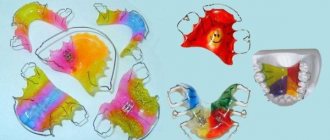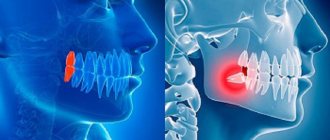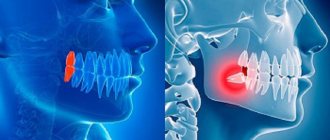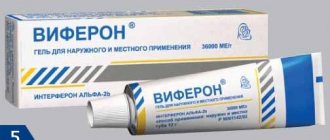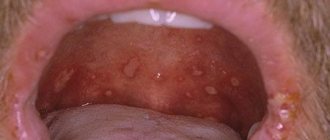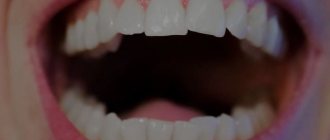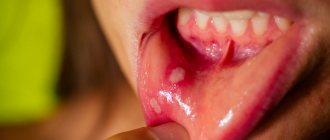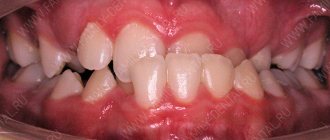The eruption of wisdom teeth is a natural process, which for some goes unnoticed and painlessly, while for others it causes a lot of trouble. For example, when a wisdom tooth grows into the cheek. The symptoms of this pathology will be described below with photographs and advice from specialists. You cannot let the situation take its course, otherwise unpleasant consequences may arise, deterioration of well-being and the condition of neighboring teeth.
Regardless of a person’s actions, his hygienic culture, lifestyle and health, each dental unit has its own direction of growth and its own characteristics. Pathologies usually arise due to genetic and natural predisposition, which are practically not amenable to any influence.
How to determine?
There are several signs by which you can immediately understand that a tooth is growing in the wrong direction. This is evidenced by:
- Pain at the end of the dentition.
- Pain and bleeding from mechanical stress, such as brushing teeth or chewing hard food.
- Swelling and hyperemia of the soft tissues near the inside of the cheek.
- Most often, the teething process is delayed for several months or even several years.
- It is visually noticeable that the apex of the tooth is located abnormally.
Symptoms of the problem
The reasons for the incorrect eruption of third molars are the lack of ready-made conductive canals, since there are no milk analogues. However, formation begins as early as five years of age, causing discomfort and pain.
Malposition and pain during growth are usually caused by the following reasons:
- jaw abnormalities, including hereditary ones;
- the position of the molars is incorrect;
- there is an excessive number of ones in the row, there is not enough space for eights;
- the shape and size of the molars are non-standard;
- hormonal disorders of the patient, metabolic problems;
- early removal of a tooth, the appearance of large gaps.
In the normal position of the teeth and jaw, eruption occurs almost imperceptibly, there is no pain or inflammation, and the figure eights take their position. But with a narrow jaw, severe pain and swelling appears, the tooth begins to grow sideways, growing into the surrounding oral tissues. This is accompanied by the following symptoms:
- bleeding, pain also occurs when brushing or flossing;
- discomfort during chewing loads;
- mucosal tissues are swollen, discoloration is observed;
- the inner surface of the cheek is injured, it is constantly bitten, and swelling appears when ingrown;
- swelling and signs of inflammatory processes appear in the gums and tongue;
- headaches, fever appear, and the condition worsens.
In especially severe cases, eruption lasts for several years, during which the patient constantly feels pain and discomfort. This requires contacting a doctor, who, after examination, chooses a treatment method.
What to do?
If a wisdom tooth causes severe discomfort and erupts in the wrong position, it will most likely have to be removed; there is no other solution to the problem. It is better to entrust such complex dental removal to a real professional so that the procedure is carried out according to all the rules. First you need to carry out diagnostics to understand the exact location of the unit. For this purpose, an X-ray of the jaw is performed. Let's consider a step-by-step algorithm for surgical intervention:
- Use of local anesthetic. High-quality long-acting medications are needed, since wisdom tooth removal can take several hours.
- Excision of soft tissue is performed.
- Using a drill to create access to the tooth root.
- Using special forceps, the tooth is removed from the oral cavity.
- The wound is carefully treated with antiseptic agents.
- Stitches are required to stop the bleeding.
Many patients ask the same question: is it possible to leave a tooth in the mouth and not remove it? Experts say that this is quite possible if the new unit does not cause pain or discomfort and does not interfere with neighboring teeth.
Causes of pathology
The formation of the structure of the future jaw apparatus and the formation of hard tissues occur in the prenatal period. And anomalies and individual characteristics appear with age, when the eruption of a specific unit begins. Experts identify typical violations during the growth of “eights”:
- development proceeds incorrectly if the rudiment has an abnormal shape and direction;
- the last tooth stands out from the general row due to its large size or unusual shape. There is not enough space for it to be positioned correctly on the jaw;
- There are not enough minerals for normal tooth growth due to general metabolic disorders;
- jaw pathologies can also provoke disruption of the hormonal system;
- there is crowding, an increased number of units in a row. There is simply no room for a figure eight on the jaw arch;
- Sometimes jaw pathology is observed in the opposite situation: excess space for a wisdom tooth provokes its incorrect position.
Whatever the cause of the pathology, it is impossible to correct it at home. If you have such a problem, it is recommended to immediately seek medical help to correct or surgically remove the unit.
Recommendations after tooth extraction
Removing a complex tooth is considered a full-fledged operation. For this reason, dentists recommend carefully observing the rehabilitation period so as not to provoke the development of complications:
- At the end of the dental procedure, the doctor places a gauze pad. Do not rush to remove it from your mouth; keep the turunda in your mouth for at least 15 minutes.
- When you get home, apply a cool compress to your cheek. This will help avoid severe swelling and soothe the aching pain.
- Do not self-medicate, take only those medications prescribed by the doctor.
- Rinsing the mouth is only permissible on the recommendation of a doctor. As a rule, short-term antiseptic baths are done to prevent the proliferation of pathogenic microflora.
- Monitor your body temperature. If it increases, you should see a dentist.
- Do not heat your tooth under any circumstances. Don't take a bath and limit strenuous physical activity for a week.
- Eat soft foods that can be consumed through a straw.
- If you experience disturbing symptoms, do not ignore going to the doctor.
- If after the end of the painkiller you are in pain, you are allowed to take a painkiller tablet in accordance with the instructions.
Consequences
Launched processes cause serious complications, including the destruction of neighboring units and their loss. In addition, the consequences include:
- destruction of the roots of adjacent units;
- damage to the enamel of the seventh units, development of caries;
- signs of inflammatory processes and severe swelling appear on the cheek;
- facial asymmetry appears;
- the development of inflammatory processes in bone tissue, the appearance of phlegmon, periostitis, pericoronitis and other diseases;
- soft tissues become denser, degeneration occurs, which can cause the appearance of malignant and benign tumors.
You can exclude complications by consulting a doctor in a timely manner. After diagnosis and external examination, the doctor will assess the condition, predict eruption and choose treatment methods. In some cases, serious intervention is not required, but if it grows sideways or in the cheek, the doctor recommends removal.
Reasons for the abnormal location of the unit
In dentistry, wisdom teeth are called third (last) molars. Their eruption is noted at the age of 17-25 years. The given figures are arbitrary; in some patients this condition is observed at an earlier or later age. In many adult patients, the figure eights remain retracted and do not appear on the gum surface.
It should be noted the main factors that lead to wisdom teeth growing into the cheek:
- pathologies of intrauterine development;
- malnutrition in infancy and childhood;
- severe infectious diseases;
- chronic systemic diseases;
- abnormalities in the structure of the jaw caused by external (trauma) or internal abnormalities in the body;
- incorrect location of the rudiments of eights (diagonally or horizontally);
- too hard or soft gum tissue;
- large unit crowns.
The main cause of the problem is a violation of the formation of the fetus in the prenatal period, despite the fact that the last molars appear on the surface in adulthood.
If a child has problems with the eruption of milk elements, then most likely the wisdom teeth will grow crooked
Another common cause of pathology is the incorrect location of the molar buds. In this case, the crown cuts into the cheek or grows into the adjacent tooth. Each of the listed cases requires removal of the problematic element, otherwise it threatens the development of serious problems.
When the unit is tilted towards the cheek, permanent injury to the soft tissue occurs. Benign tumor cells, which arise as a result of friction of the crown against the mucous membranes, degenerate into oncological structures. When a wisdom tooth deviates towards the seven, the root system of several elements is destroyed. In addition, the described condition increases the risk of enamel caries.
Retracted wisdom teeth are a problem for modern people, associated with a decrease in the size of the jaw due to a decrease in the chewing load on them. The problem affects people with malocclusions and patients with healthy row elements. If the last filler does not have enough space during the eruption process, then the wisdom tooth grows incorrectly, making its way to the surface of the gum.
Carious lesion of the wisdom tooth and the adjacent “seven”
It takes a lot of effort to really clean teeth that are far from the center, so their level of hygiene usually leaves much to be desired. They do not take an active part in the chewing process, so they also do not clean themselves. In the accumulating plaque, pathogenic microflora very quickly develops, causing the need for treatment of caries. Since, due to lack of space, the “figure eight” is often located obliquely, caries also affects the adjacent tooth - in the area of their contact.
Pericoronitis of the wisdom tooth is a serious danger to health and even life
Between the erupting tooth and the gum a so-called “hood”, which promotes the accumulation of food debris and the growth of colonies of pathogenic bacteria. Ideal conditions are created for the development of pericoronitis - a purulent inflammatory process. In this case, the gums swell and swell, the body temperature rises, the patient experiences severe pain, and an unpleasant taste and smell appears in the mouth. The inflammatory process can spread to the periosteum, causing periostatitis, and even to the bone tissue of the jaw, causing a deadly disease - osteomyelitis.
Pathologies that require dental care
Eights can take several days, months, or even years to erupt. Growth is accompanied by a slight aching pain, swelling, and redness of the gums - this is the norm.
But there are a number of symptoms that indicate the development of complications and when you should consult a dentist:
- severe acute pain in the gum area;
- pain that spreads to the ear, throat, temples, head;
- increased body temperature;
- inflammation of gum tissue, purulent discharge;
- the appearance of bad breath;
- discomfort, pain when chewing;
- pain when opening the mouth;
- enlarged lymph nodes.
These are signs of inflammation that can lead to infection, loss of adjacent teeth, and sepsis.
Possible pathologies during the eruption of wisdom teeth:
- Incorrect position of the tooth, as a result, it grows sideways into the cheek, injuring, causing pain and inflammation of the soft tissues. At the same time, it causes displacement of the remaining dental units and malocclusion. In the worst case, a malignant tumor may form. It is impossible to correct the direction of growth; the incorrectly growing molar must be removed.
- If it grows towards an adjacent unit, it will damage or completely destroy its crown. The pathology is accompanied by constant severe pain, the inability to chew food normally, and talk. The solution to the problem is surgical removal.
- Pericoronitis is inflammation of the gums. Since the third molars are located in an area that is difficult to clean, leftover food, drinks, and microbes get into the gum tissue. Bacteria cause infection, inflammation, dangerous intoxication of the body, blood poisoning. Symptoms of pericoronitis include severe swelling of the gums, facial asymmetry, acute persistent pain, purulent discharge, and high fever. You should contact the clinic immediately.
Prohibited actions
Any oral medications are allowed to be taken for no more than 3-4 days, regardless of the strength of the therapeutic effect. Do not heat or rinse the damaged area with hot solutions. High temperature increases the rate of reproduction of pathogenic flora. After the procedure, swelling usually increases, and signs of inflammation become more pronounced.
It is forbidden to apply folk remedies with an aggressive composition to damaged mucous membranes: alcohol compresses, onions, garlic, lemon. Such actions negatively affect the process of soft tissue regeneration
